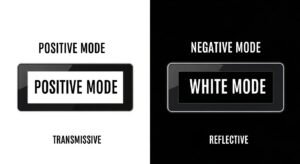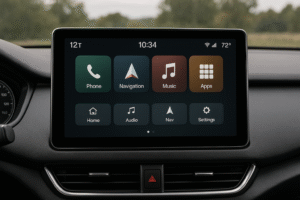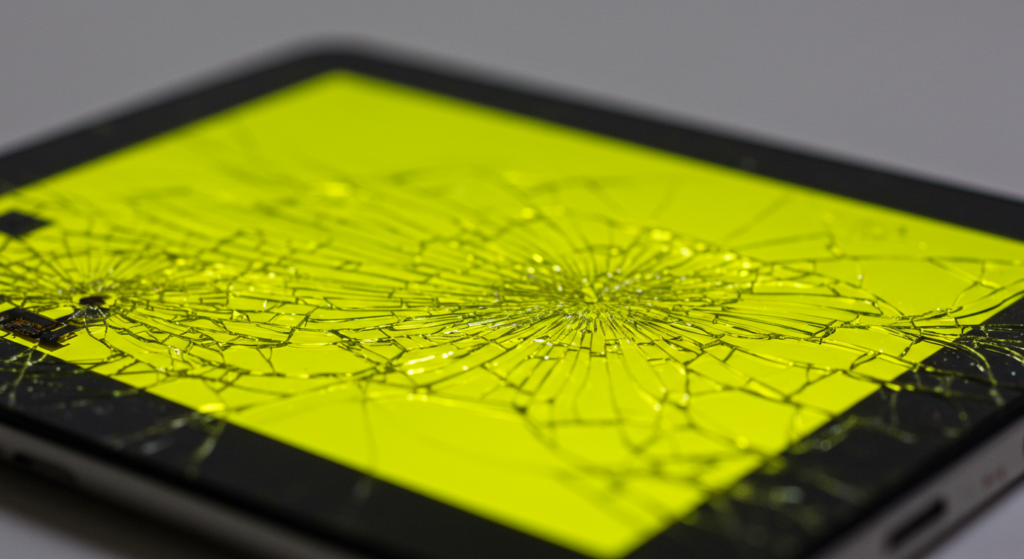
Broken screens often show visible issues like cracks, discoloration, and pixel malfunctions. These patterns are the result of physical damage to the screen’s layers and internal components. Cracks typically occur when the screen experiences pressure or impact, breaking the surface layer. Discoloration happens when the liquid crystals or pixels inside the screen are damaged, causing color distortion.
Pixel malfunctions can lead to lines or blocks of color that don’t match the original display. These issues arise when individual pixels or groups of pixels fail to function properly due to physical damage. The type of display technology, such as LCD or OLED, also affects how the damage appears. LCD screens might show dark spots or lines, while OLED screens can develop colorful or irregular patterns, especially when damaged.
Understanding why broken screens look like this helps you assess the severity of the damage and decide on the right course of action for repair.
Why Do Broken Screens Look Like That?
When a screen breaks, it often shows visual damage such as cracks, discoloration, or pixelation. These effects happen because of damage to the screen’s surface or underlying layers.
When a screen cracks, the pressure disrupts the pixels, causing areas of the display to malfunction. Discoloration often occurs because the liquid crystals in the screen cannot function correctly, leading to a shift in color or brightness. A common result is a color broken screen, where parts of the screen show different colors or become completely black. This can also happen when the colorful broken screen effect appears, particularly on older screens or those subjected to significant impact. These issues arise because broken screens fail to transmit the signal needed for a consistent display, leading to pixel misalignment or dead pixels.
- Cracks and Pixel Misalignment: A crack on the screen disrupts the alignment of pixels, causing them to malfunction. This may result in black spots or distorted color patterns.
- Discoloration and Dead Pixels: When the display is damaged, the liquid crystals inside the screen can no longer react to the electrical signals, leading to dead pixels or abnormal coloring. This is especially visible in areas where a color broken screen effect shows different colors than intended.
- Colorful Broken Screen Effect: A colorful broken screen can occur when certain sections of the screen are more severely impacted, often leading to rainbow-like color effects or pixelated, jagged lines on the screen.
What Causes the Colorful Broken Screen Effect?
A colorful broken screen often occurs due to severe physical damage or internal electrical issues within the screen’s circuits.
The colorful broken screen effect can happen when multiple pixels fail at once, often due to a sharp impact or pressure on the screen. In these cases, parts of the screen might display unexpected bright colors, typically purple, green, or blue, which are not part of the normal display function. This effect may vary depending on the screen’s technology, but it often indicates that the screen’s hardware is malfunctioning, particularly in devices with complex displays like smartphones and high-end monitors.
- Pixel Cluster Failure: When the screen suffers from a direct impact, the damage can cause a cluster of pixels to stop functioning properly, leading to a colorful broken screen.
- Electrical Short: An electrical short can cause a group of pixels to malfunction, leading to the appearance of random colors or patterns on the screen(How does an electrical short affect LCD screens?).
- Impact on Liquid Crystals: In LCD and OLED screens, an impact can cause the liquid crystals to fail, which may result in the screen displaying an unintended range of bright colors, forming a colorful broken screen pattern.
Why Do Broken Screens Appear Colorful or Have Lines?
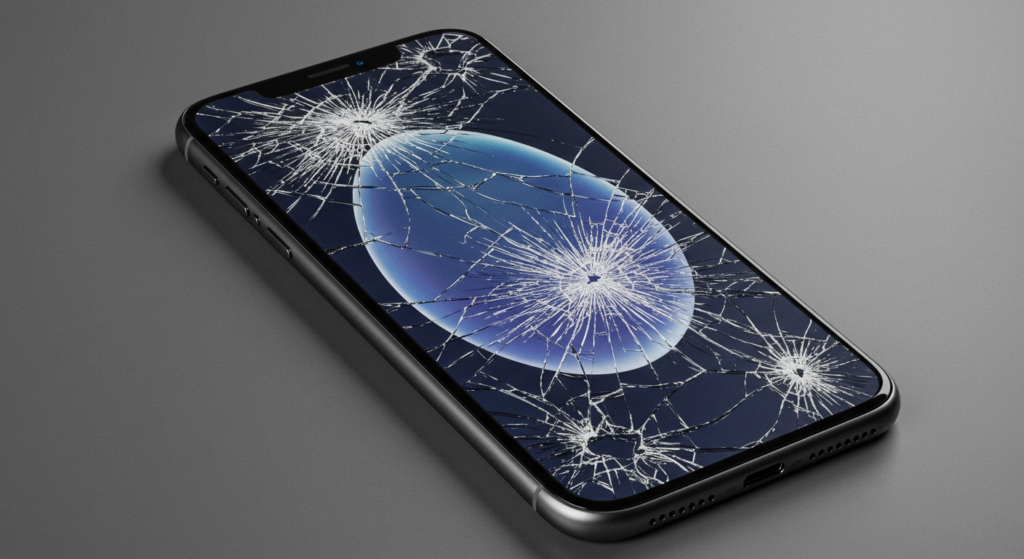
Broken screens can appear colorful or show lines due to damage to the screen’s structure, which disrupts the normal functioning of pixels.
When a screen is cracked or impacted, the liquid crystals in an LCD or OLED display can become misaligned. This can cause certain areas to malfunction, resulting in color broken screen effects or visible lines. A colorful screen often appears when the damage affects the electrical pathways that control color rendering, while lines can appear due to damaged or dead pixels that no longer function properly. Colorful broken screen effects are particularly noticeable in areas of heavy impact, and the color distortion is a direct result of internal circuit failure.
- Liquid Crystal Damage: When liquid crystals in an LCD or OLED screen are damaged, they cannot properly adjust to electrical signals, leading to color distortion and a colorful broken screen. This is caused by physical pressure or impact disrupting the alignment of crystals.
- Pixel Malfunction and Lines: Damaged pixels may fail to display the correct colors, causing vertical or horizontal lines to appear across the screen. In severe cases, this can result in a color broken screen effect, where these lines become visibly colored.
- Impact on Display Technology: The way a screen breaks depends on the technology used. For example, LCD screens are more prone to pixel misalignment from pressure, while OLED screens can suffer from “burn-in” or irregular coloring when the individual pixels are damaged. The difference in display technologies affects how colorful broken screens appear after damage.
What Role Do Different Screen Types Play in Colorful Broken Screens?
Different screen types, such as LCD and OLED, impact how a broken screen appears, particularly in terms of color distortion and line visibility.
For example, OLED screens are more likely to exhibit uneven color or “burn-in” after physical damage, leading to colorful distortion, while LCD screens tend to show lines or patches of discoloration due to pixel misalignment. The colorful broken screen effect can appear more pronounced in OLED screens due to the individual pixel control, which is more sensitive to damage than the liquid crystal layers of an LCD screen(How do LCD and OLED screens differ in their technology?).
- LCD Screens: When LCD screens break, cracks or pressure can cause the liquid crystals to malfunction, leading to lines and localized color broken screen effects. This typically results in visible black spots or discoloration in certain areas.
- OLED Screens: OLED panels have self-emitting pixels, meaning each pixel controls its own brightness and color. Physical damage to an OLED screen can cause a colorful broken screen effect, with distorted colors or burn-in patterns more visible across the screen.
Are There Functional Impairments with Broken Screens?
Yes, broken screens can lead to functional impairments, affecting both touch sensitivity and display quality.
Cracks or other damage to a screen can interfere with the screen’s ability to register touch inputs. As for the display, pixelation or changes in color can significantly reduce the screen’s clarity and accuracy. A broken screen can create visual anomalies like dead pixels or distorted colors, which make it difficult to use the device for tasks that require a clear display. Additionally, minor cracks can lead to bigger issues, as they often cause more damage over time, affecting internal components of the device.
- Touch Sensitivity Issues: When a screen is cracked, the underlying touch sensors may fail to register touch inputs properly. This is particularly true for capacitive touchscreens(What are capacitive touchscreens and how do they work?), where cracks disrupt the electrical fields needed to detect user interaction, resulting in unresponsive or inaccurate touch input.
- Display Malfunctions: A cracked screen can cause pixel misalignment or malfunction, leading to color broken screen effects, where certain parts of the screen no longer display the correct colors. This can make it difficult to view images, videos, or read text properly.
- Escalating Problems: Ignoring minor damage, such as small cracks or discoloration, can worsen over time. Pressure on a cracked screen can cause further damage to the internal layers, such as the LCD or OLED panel, potentially leading to permanent screen malfunction or more serious device issues.
What Happens When Minor Screen Damage is Ignored?
Ignoring minor screen damage can lead to more significant problems, including the worsening of display issues and potential internal damage to the device.
When a small crack or discoloration is left untreated, it can spread, causing additional pixelation or even further cracking. As damage spreads, it may begin to impact the device’s internal components, potentially leading to more expensive repairs or even complete device failure. Over time, the pressure on the damaged area can cause other components, like the touch sensors, to fail completely.
- Spread of Damage: Small cracks can worsen with continued use, especially under pressure or impact. As cracks spread, they can cause further disruption to the pixels, resulting in a more noticeable colorful broken screen.
- Internal Device Damage: Prolonged pressure on a cracked screen can eventually affect internal circuits or components like the touch sensor or motherboard, leading to more costly repairs.
Safety Risks of Using a Broken Screen
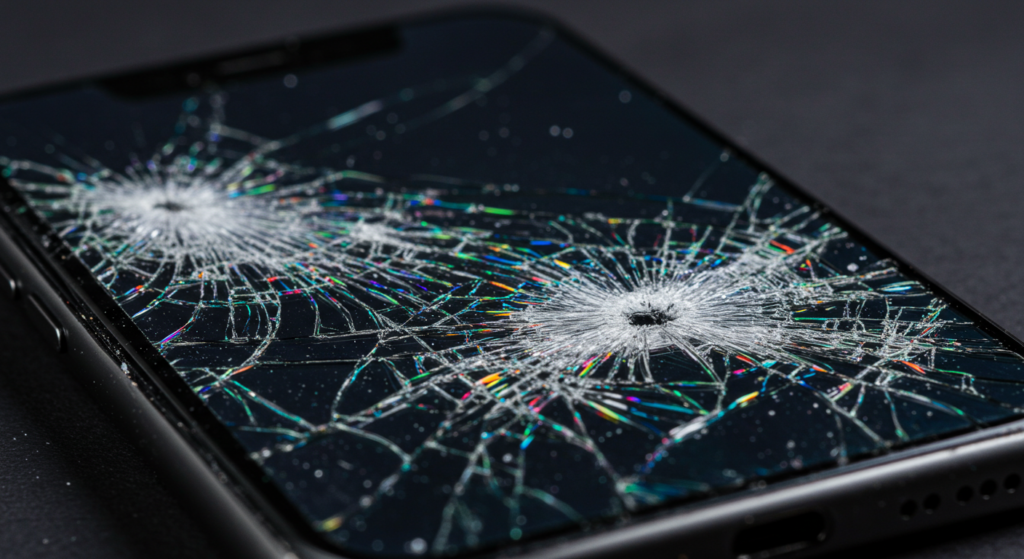
Using a broken screen can pose several safety risks, including potential injuries from sharp edges and other hazards in specific environment(How can I handle a device with a cracked screen safely?)s.
Cracked or shattered screens have jagged edges that can cause cuts or puncture wounds if not handled carefully. In addition to the risk of injury, a broken screen can expose sensitive internal components, such as the battery or electrical circuits, which may pose additional dangers. In environments with children or pets, these risks are heightened, as they may inadvertently touch or interact with the damaged screen, leading to possible harm.
- Sharp Edges and Injury Risks: Cracks and shattered glass can leave sharp edges that are dangerous if touched. The jagged glass can easily cause cuts, especially if the device is not properly handled or covered.
- Exposure to Internal Components: A broken screen can expose internal components such as batteries, which could leak harmful substances or even overheat, posing potential fire or chemical hazards.
- Environmental Risks: In environments where children or pets are present, a broken screen increases the likelihood of accidental injury or ingestion of small fragments. If the device is dropped or tampered with, these fragments can become dangerous.
How to Safely Handle a Broken Screen?
If you need to use a device with a broken screen, it’s important to handle it safely to avoid injury or further damage.
One should always cover the broken screen with protective tape or a screen protector to prevent sharp glass edges from causing harm. Additionally, using a sturdy case or placing the device in a safe location can minimize the risk of further damage or exposure to internal components.
- Using Protective Tape: Applying strong tape over the cracks can help prevent sharp edges from causing cuts. It also reduces the risk of further screen damage.
- Safe Handling: Using a durable case or keeping the device in a safe place away from children or pets can help avoid unnecessary exposure to hazards.
How Can You Repair a Broken Screen?
Repairing a broken screen can be done through DIY methods or by seeking professional services, each with its own set of advantages and drawbacks.
DIY repairs can be a cost-effective solution, especially for minor cracks, but they require the right tools, skills, and time. Professional repairs, on the other hand, ensure the job is done properly, but they can be more expensive. When deciding which option to choose, it’s important to weigh the severity of the damage, your budget, and whether you are comfortable with the repair process(Is it worth repairing a broken screen?).
- DIY Screen Repairs: For minor cracks or scratches, DIY repairs are possible using kits available online. These typically include screen adhesive, tools to open the device, and instructions. However, this method is best suited for those with some technical knowledge. Poor handling could lead to further damage.
- Professional Repair Services: Professionals use high-quality parts and offer warranties, ensuring the repair is completed correctly. While more expensive, professional repairs can save time and provide peace of mind, especially for more serious screen damage.
- Choosing Between DIY and Professional: If the screen is severely damaged, DIY repairs are generally not recommended as they could lead to more damage. In such cases, opting for professional repair ensures the device is restored to full functionality.
What Should You Consider Before Repairing Your Broken Screen?
Before deciding to repair a broken screen, consider the cost of repair, the value of your device, and the possibility of data loss during the process.
It’s important to evaluate whether the device is still worth repairing, especially if it’s old or if the screen is severely damaged. Additionally, make sure to back up your data before repair to prevent any loss during the process.
- Cost of Repair vs. Device Value: If the cost of repair is close to or exceeds the value of the device, it might be more cost-effective to replace the device altogether. Consider factors like the age of the device and potential future repairs.
- Data Backup: Before any repair, make sure to back up your data to a cloud service or external storage device. This ensures you don’t lose important information if the repair process affects your device’s storage.
How to Prevent Future Screen Damage?
Using protective accessories and following best handling practices can significantly reduce the chances of future screen damage.
To protect your device from screen damage, it’s crucial to invest in durable cases and screen protectors. Additionally, adopting mindful handling habits can go a long way in preventing accidental drops or cracks. By ensuring the device is always securely stored and handled, you can protect the screen from unnecessary wear and tear.
- Protective Accessories: Screen protectors act as a first line of defense against scratches and minor impacts. A well-fitted shockproof case can absorb impact and prevent cracks or shattering, especially in the event of drops. There are also wallet-style cases that offer additional protection by covering the entire device.
- Best Handling Practices: Always hold the device with both hands when in use, especially if it’s a larger device. Avoid placing it in pockets or bags where it could be exposed to pressure or sharp objects. When placing the device down, ensure it’s on a flat, secure surface to minimize the risk of accidental drops.
What Should You Do Immediately After Screen Damage?
If your screen gets damaged, acting quickly can minimize further harm to your device.
If you notice any cracks or issues with your screen, it’s crucial to stop using the device and assess the damage. Covering the screen with protective tape or placing it in a safe location can prevent further damage. If possible, back up your data immediately to prevent any potential data loss.
- Preventing Further Damage: Apply protective tape over cracks to reduce the risk of sharp glass causing injury or further cracking. Keeping the device in a safe, secure place will help avoid additional pressure or impact.
- Data Backup: Ensure all important files and data are backed up to a cloud storage or external device. This is essential before getting the screen repaired or replacing the device.
Related Screen Articles:
Phenomenon and explanation of LCD display
The Effect of Temperature on the Functional Performance of LCD Modules
Summary:
Broken screens can show various issues, such as cracks, discoloration, or pixel malfunctions, due to damage to internal components. Understanding the causes and visual patterns of screen damage helps you assess the condition of your device and decide whether to repair or replace it. Taking preventive measures, such as using protective accessories and handling devices carefully, can significantly reduce the risk of future damage.
FAQ
Why Do Broken Screens Look Colorful?
Broken screens may appear colorful due to liquid crystal damage or pressure that distorts the display, leading to colorful or pixelated effects.
Can a Broken Screen Be Fixed by Yourself?
DIY repairs are possible but may be challenging; professional repair services are often more reliable for complex damage.
How Long Can I Use a Device with a Cracked Screen?
It’s advisable to fix a cracked screen soon to avoid worsening the damage, but if used for too long, internal components might also be affected.
Is a Broken Screen Dangerous to Use?
Yes, using a broken screen can pose physical risks due to sharp edges and may also cause further internal damage.
How Can I Prevent Future Screen Breaks?
Use a protective case, screen protector, and avoid dropping the device to minimize the risk of screen damage in the future.
How Much Does it Cost to Repair a Broken Screen?
Repair costs vary depending on the device type and damage extent, but it’s often cheaper to repair minor cracks early on rather than wait for further damage.




